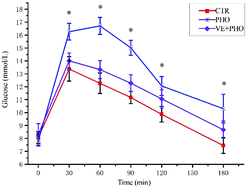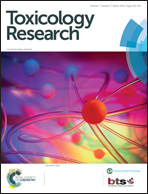Changes in glucose metabolism and mRNA expression of IRS-2 in rats exposed to phoxim and the protective effects of vitamin E†
Abstract
Research has shown that organophosphorus pesticides impair glucose homeostasis and cause insulin resistance and type 2 diabetes. The current study investigates the influence of phoxim on insulin signaling pathways and the protective effects of vitamin E. Phoxim (180 mg kg−1) and VE (200 mg kg−1) were administered orally to Sprague-Dawley rats over a period of 28 consecutive days. After exposure to phoxim, the animals showed glucose intolerance and hyperinsulinemia during glucose tolerance tests, and insulin tolerance tests demonstrated an impaired glucose-lowering effect of insulin. Phoxim increases the fasting glucose, insulin and cholesterol levels, as well as the liver hexokinase activity (HK) significantly while decreasing the high density lipoprotein (HDL) cholesterol, and glycogen content in the liver and skeletal muscles observably. Furthermore, we observed an increase of insulin resistance biomarkers and a decrease of insulin sensitivity indices. The insulin receptor substrate (IRS)-2 mRNA expressions of liver and skeletal muscles were down-regulated by phoxim, while the expression of IRS-1 showed no difference. There were no differences in triglycerides, LDL-cholesterol, and fasting glucose treated with phoxim. On the basis of biochemical and molecular findings, phoxim has been determined to impair glucose homeostasis through insulin resistance and insulin signaling pathway disruptions resulting in a reduced function of insulin in hepatocytes and muscles. VE supplementation reduced the fasting glucose, increased the glycogen content and HDL-cholesterol, but did not reduce the insulin resistance indices, when phoxim-treated rats were compared to VE supplemented rats. Overall, this study shows that vitamin E modifies the phoxim toxicity in rats only to a moderate degree.



 Please wait while we load your content...
Please wait while we load your content...